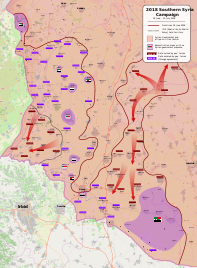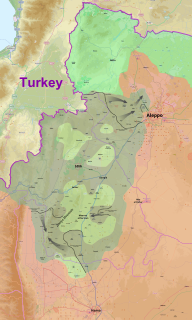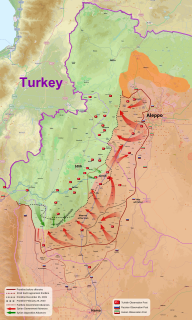 W
WOn 16 March 2017, an airstrike by the United States Armed Forces killed up to 49 people in the rebel-held village of al-Jinah near Aleppo, Syria. The US military claimed the people targeted in the strike were militants belonging to the terrorist group al-Qaeda. However, the Syrian Observatory for Human Rights (SOHR), local residents and local officials have claimed that the building struck was a mosque filled with worshipers. At the time, US military claimed that the structure bombed was not a mosque itself but was next to a mosque, which was undamaged. However, on May 5, 2017, a US Central Command investigation determined that the building was indeed part of a mosque-complex. Rami Abdel Rahman, head of SOHR, claimed the structure was a mosque which held over 300 people at the time of the strike. In September 2017, the United Nations Commission of Inquiry on Syria concluded that "United States forces failed to take all feasible precautions to avoid or minimize incidental loss of civilian life, injury to civilians and damage to civilian objects, in violation of international humanitarian law." The UN commission's findings did not support the U.S. claim that an al-Qaeda meeting was taking place.
 W
WThe Beit Jinn offensive was a military operation by the Syrian Arab Army against opposition groups in the Western Ghouta area, starting on 28 November 2017.
 W
WThe Daraa offensive , code named as the battle of "Death Rather than Humiliation" by the rebels, was a military operation launched by Syrian rebels against positions of the Syrian Arab Army in the Manshiyah District of Daraa city, in southern Syria, during the Syrian Civil War.
 W
WThe Daraa offensive was a military operation launched by the Syrian Arab Army and allies against rebel positions in the southern half of Daraa city. Rebels and government forces fought for control of the city's Palestinian refugee camp, a built-up residential area of the city.
 W
WThe 2018 Southern Syria offensive, code-named Operation Basalt, was a military operation launched by the Syrian Arab Army (SAA) and its allies against the rebels and ISIL in Southern Syria. The fighting started with a surprise attack on rebel-held areas in the eastern part of the Daraa Governorate in an attempt to fracture rebel-held lines and weaken morale, ahead of their offensive in the greater Southern Syria region.
 W
WOn 17 April 2018, rebel groups in the eastern Qalamoun Mountains pocket, led by Jaysh al-Islam, reached a surrender agreement with the Syrian Army and Russia. The agreement came after 2 weeks of negotiations that began with a Syrian Army ultimatum on 3 April. Around 1,500 rebels handed over heavy weapons and equipment to the Syrian Army, and were evacuated by 124 buses in 4 convoys to Turkish-held areas in the northern Aleppo Governorate along with their families, totaling around 5,000 people. On 25 April, the last batch of rebels and their families left the eastern Qalamoun pocket, and the region came under full Syrian government control.
 W
WThe Hama offensive was a military offensive launched by Syrian rebel groups led by Hay'at Tahrir al-Sham (HTS) north of the city of Hama, as part of the Syrian Civil War. The offensive began on 21 March 2017, and the rebels aimed to recapture areas recaptured by the Syrian Armed Forces in the 2016 Hama offensive, as well as pushing into Hama city. The offensive was coordinated with rebel forces in Damascus' eastern suburbs, who launched their own operation in March 2017.
 W
WThe Hama offensive , code-named Oh Servants of God, Be Steadfast, was a military offensive launched by rebel groups led by Hayat Tahrir al-Sham (HTS) north of the city Hama, as part of the Syrian Civil War.
 W
WThe Idlib Governorate clashes were military confrontations between Syrian rebel factions led by Ahrar al-Sham and their allies on one side and the al-Qaeda-affiliated Jabhat Fatah al-Sham and their allies on the other. After 7 February, the clashes also included Jund al-Aqsa as a third belligerent, which had re-branded itself as Liwa al-Aqsa and was attacking the other combatants. The battles were fought in the Idlib Governorate and the western countryside of the Aleppo Governorate.
 W
WThe Idlib Governorate clashes were a series of armed confrontations between the Be Steadfast Operations room, led by the Guardians of Religion Organization, and Hayat Tahrir al-Sham. The conflict began after HTS arrested the leader of the Ansar al-Din Front, Abu Salah Al-Uzbeki, and a dissenting leader of a group within HTS.
 W
WThe National Front for Liberation–Tahrir al-Sham conflict began on 1 January 2019 during clashes between Nour al-Din al-Zenki Movement and Hayat Tahrir al-Sham (HTS), after HTS launched an attack against the group in Darat Izza, Taqad, and Khan al-Asal fronts in rebel-held western Aleppo. The conflict ended on 10 January 2019, after the National Front for Liberation agreed to withdraw, allowing HTS to take over almost all of the remaining opposition-held areas of the Idlib pocket.
 W
WThe Idlib demilitarization was an agreement between Turkey and Russia to create a demilitarized zone (DMZ) in Syria's rebel held Idlib Governorate, to be patrolled by military forces from Russia and Turkey. On 17 September 2018, the Russian president Vladimir Putin and Turkish president Recep Tayyip Erdoğan, reached an agreement to create a buffer zone in Idlib.
 W
WThe Northwestern Syria campaign was a large-scale military operation that initially started with an offensive conducted by ISIL forces on areas controlled by Tahrir al-Sham (HTS) in the northern Hama Governorate. Subsequently, the Syrian Armed Forces launched their own offensive against HTS and other rebel groups in the area. The campaign took place at the intersection of the provinces of Hama, Idlib and Aleppo.
 W
WThe 2019 northwestern Syria offensive, codenamed "Dawn of Idlib", was a military operation launched on 30 April 2019 by the Syrian Armed Forces and its allies against rebel groups in northwestern Syria during the Syrian Civil War in a region known as "Greater Idlib", consisting of northwest Hama, southern Idlib and northeastern Latakia provinces. The government's main objectives were to open the M5 highway and to expel non-compliant militant groups, particularly the internationally proscribed al-Qaeda-linked group known as Hayat Tahrir al-Sham (HTS), from the 15–20 km demilitarized zone demarcated by Turkey and the Russian Federation at Sochi in 2018. The offensive was seen by both parties as crucial to the outcome of the war.
 W
WThe 2019–2020 northwestern Syria offensive, codenamed "Dawn of Idlib 2", was a military operation launched by the armed forces of the Syrian Arab Republic, Russia, Iran, Hezbollah and other allied militias against Syrian opposition and allied fighters of the Syrian National Army, Hayat Tahrir al-Sham, Rouse the Believers Operations Room, the Turkistan Islamic Party, and other rebel and Salafi jihadist forces in Idlib and surrounding governorates during the Syrian Civil War. The offensive began on 19 December 2019 and saw Russian-backed pro-government forces clash with Turkish-backed opposition groups. The offensive displaced 980,000 civilians.
 W
WThe Qaboun offensive (2017) was a military operation of the Syrian Arab Army in the suburbs of Damascus against rebel forces during the Syrian Civil War. Its intended goal was to capture the Damascus suburbs of Qaboun and Barzeh from rebels led by Hay’at Tahrir al-Sham (HTS).
 W
WThe Rif Dimashq offensive , code-named Operation Damascus Steel, was a military offensive launched by the Syrian Arab Army (SAA) in February 2018 in a bid to capture the rebel-held eastern Ghouta suburb during the Syrian Civil War. East Ghouta, a pocket of towns and farms, had been under government siege since 2013 and had been a major rebel stronghold in the vicinity of the capital of Damascus. According to the United Nations, nearly 400,000 people live in East Ghouta.
 W
WThe Southern Damascus offensive began on 5 January 2018 as Jaysh al-Islam fighters attempted to infiltrate ISIL positions within the orchards situated in-between Yalda and Hajjar As-Aswad to the immediate south of Damascus city. This resulted in numerous casualties and as such, a week later, on 12 January ISIL shock troops launched a counter-assault on Yalda's Zein neighborhood, triggering heavy clashes, resulting in the eventual capture of several buildings in the area. On 22 January, ISIL made further progress in Taqdam Neighborhood of Hajjar al-Aswad, to this date ISIL ended up controlling 3/4 of Yarmouk Camp, majority of Hajjar al-Aswad, Qadam, Tadamon and large part of Yalda's eastern axis. Fighting continued with ISIL forces continuing their advance against other militant groups later into January, with majority of a street between Yalda and Babbila as well as some gains within the district of Tadamon. By 27 January, ISIL controlled almost the entirety of Hajjar al-Aswad after breaking through the last lines of defense and were on the verge of entering the town of Yalda, during the same time, further areas were also captured in the Yarmouk district.
 W
WThe Southern Damascus offensive started on 12 March 2018, when ISIL began attacking rebel positions in the al-Qadam neighborhood of southern Damascus as they were evacuating. The rebel pocket in al-Qadam had been surrounded on one side by government forces and on the other by ISIL. On 10 March, ISIL threatened to kill any rebels that evacuate from the area after the Syrian government gave the rebels 48 hours to surrender the district and evacuate. Following news of the upcoming rebel evacuation from al-Qadam, ISIL forces attacked the rebels on 12 March and captured 25 percent of the neighborhood. The next day, around 300 rebel fighters and their family members were evacuated from al-Qadam to rebel territory in Idlib province. After the evacuation, government troops took control of 70 percent of the neighborhood, while the remaining 30 was under IS control. During the fighting, government air-strikes were conducted against ISIL in Al-Hajar al-Aswad and al-Qadam. While the clashes were taking place in Qadam, rebel groups attempted to break through ISIL lines in Yarmouk but were repelled.
 W
WThe Southern Damascus offensive began on 19 April 2018 when the Syrian Armed Forces began to clear an enclave held by the Islamic State of Iraq and the Levant (ISIL) in southern Damascus in the Yarmouk Camp.
 W
WThe Southwestern Daraa offensive was launched by an ISIL affiliate, the Khalid ibn al-Walid Army, in the southwest of Syria near the Golan Heights and on the border with Israel and Jordan.
 W
WOn 19 February 2018, heavy clashes erupted between the newly established Syrian Liberation Front, which consists of Ahrar al-Sham and the Nour al-Din al-Zenki Movement, backed by the Suqour al-Sham Brigades, and Hayat Tahrir al-Sham (HTS) in the western Aleppo Governorate. The conflict soon spread to the Idlib Governorate and the SLF captured several towns from HTS. A ceasefire between the two groups was reached on 24 April 2018. Fighting again resumed on January 1, 2019, ending with a total HTS military victory on January 9.